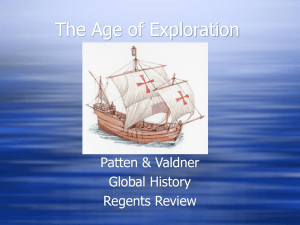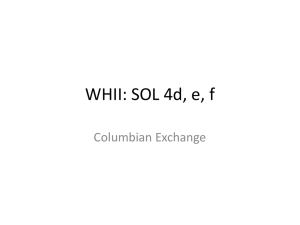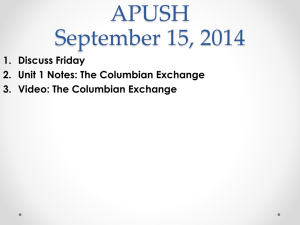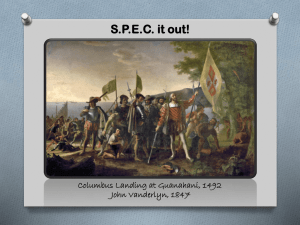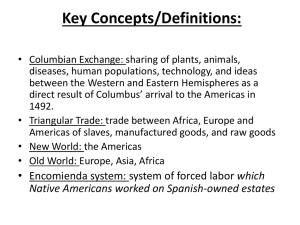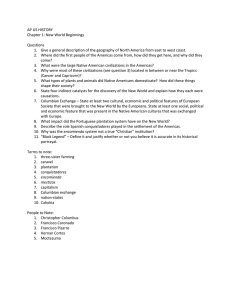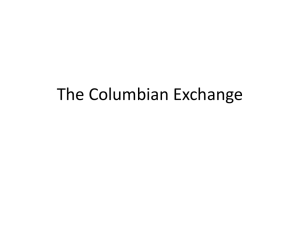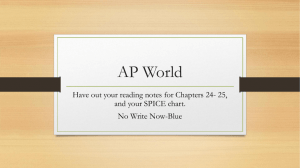DOCUMENT-BASED QUESTION: THE COLUMBIAN EXCHANGE AND THE WORLD
advertisement
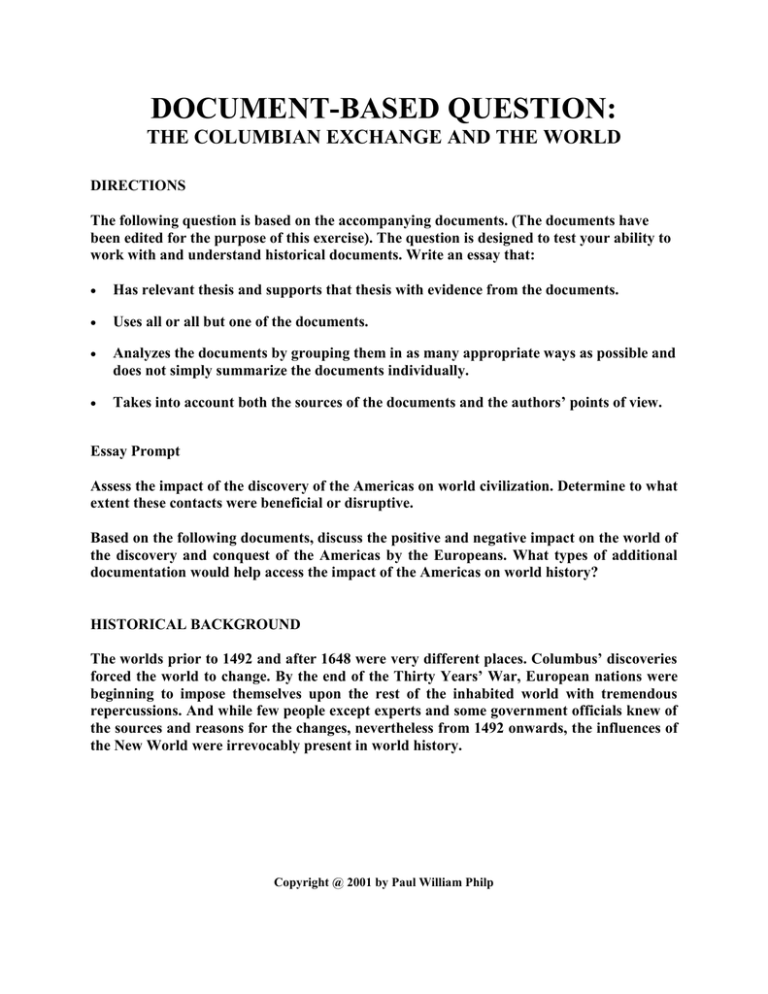
DOCUMENT-BASED QUESTION: THE COLUMBIAN EXCHANGE AND THE WORLD DIRECTIONS The following question is based on the accompanying documents. (The documents have been edited for the purpose of this exercise). The question is designed to test your ability to work with and understand historical documents. Write an essay that: Has relevant thesis and supports that thesis with evidence from the documents. Uses all or all but one of the documents. Analyzes the documents by grouping them in as many appropriate ways as possible and does not simply summarize the documents individually. Takes into account both the sources of the documents and the authors’ points of view. Essay Prompt Assess the impact of the discovery of the Americas on world civilization. Determine to what extent these contacts were beneficial or disruptive. Based on the following documents, discuss the positive and negative impact on the world of the discovery and conquest of the Americas by the Europeans. What types of additional documentation would help access the impact of the Americas on world history? HISTORICAL BACKGROUND The worlds prior to 1492 and after 1648 were very different places. Columbus’ discoveries forced the world to change. By the end of the Thirty Years’ War, European nations were beginning to impose themselves upon the rest of the inhabited world with tremendous repercussions. And while few people except experts and some government officials knew of the sources and reasons for the changes, nevertheless from 1492 onwards, the influences of the New World were irrevocably present in world history. Copyright @ 2001 by Paul William Philp DOCUMENT 1 Francesco Guicciardini, Italian historian, from his famous history book, 1537 “These voyages have not only confuted many things which had been affirmed by writers about terrestrial matters, but they have also given some cause for alarm to interpreters of Holy Scriptures, who declared that faith in Christ had spread over the entire earth through the Apostles: an interpretation contrary to the truth.” DOCUMENT 2 A chronicle kept by the Cakchiquel Mayas for their descendants, recording the impact of a European disease on their people, early 16th century “Great was the stench of the dead. After our fathers and grandfathers had succumbed, half of the people fled to the fields. The dogs and vultures devoured the bodies. The mortality was terrible. Your grandfathers died, and with them died the son of the king and his brothers and kinsmen. So it was that we become orphans, oh, my sons! So we became when we were young. All of us were thus. We were born to die!” DOCUMENT 3 Adam Smith, British economist, from his book, The Wealth of Nations, 1776 “Since the discovery of America, this market for the produce of its silver mines has been growing gradually more and more extensive and the greater part of Europe has been much improved. The East Indies is another market for the silver mines of America, and a market which has been continually taking off a greater and greater quantity of silver. Particularly in China and [India], the value of the precious metals was much higher than in Europe; and it continues to be so. The silver of the new continent seems in this manner to be one of the principal commodities by which the commerce between the two extremities of the old [world, namely Europe and India/China] is carried on, and by means of it, in great measure, that those distant parts of the world are connected with one another [in trade].” Copyright @ 2001 by Paul William Philp DOCUMENT 4 Tomas de Mercado, Dominican priest and theologian, his book of advice to merchants, 1520 “Previously, Andalucia (Southern Spain) and Lusitania (Portugal) used to be the very end of the world, but now, with the discovery of the [West] Indies, they have become its center. They (the merchants of Seville) deal in all parts of Christendom and even in Barbary (Muslim lands). To Flanders they ship wool, oil, and wine, and bring therefrom every kind. To Florence they send cochineal (dye) and hides, and bring back brocades, silk, and cloth. At Cape Verde they trade in Negroes. To the (West) Indies they ship cargoes of every merchandise, and return with gold, silver, pearls, and cochineal. The opportunities for great wealth attract some of the principal citizens into becoming merchants, when they see the vast profits to be gained the gentry through greed or necessity, have lowered themselves, if not to trade, at least to intermarry with trading families; and the merchants, with their desire for nobility, have striven to rise, and establish rich entitled estates.” DOCUMENT 5 Letter from King Affonso of Angola (Africa) to the King of Portugal, 1526 “We cannot reckon how great the damage is, since the merchants are taking every day our natives, sons of the land and vassals and our relatives, because the thieves and men of bad conscience grab them wishing to have the things and wares of this kingdom which they are ambitious of; they grab them and get them to be sold; and so great, Sir, is the corruption and licentiousness that our country is being completely depopulated. We beg of Your Highness to help and to assist us in this matter, commanding your factors [slavers] that they should not send either the merchants or wares, because it is our will that in these kingdoms there should not be any trade of slaves nor outlet for them.” DOCUMENT 6 Robert Bellarmine, French Cardinal and Jesuit, his book, Controversiae, 1593 “Heretics (Protestants) are never said to have converted either pagans or Jews to the faith. But in this century the Catholics have converted many hundreds [of thousands] of heathens in the world; yet they [Protestants] have hardly converted even so much as a handful.” Copyright @ 2001 by Paul William Philp DOCUMENT 7 AMERICAN FOODSTUFFS AND PLANTS EXPORTED TO THE WORLD Corn Beans (17 Types) Peanuts Potatoes Sweet Potatoes Tapioca Squash Papaya Guava Avocado Pineapple Tomato Chile Pepper Cocoa Pumpkin Tobacco Coca Dyes Medicinal Herbs Vanilla Blueberry DOCUMENT 8 VARIETIES OF OLD AND NEW WORLD STAPLE CROPS COMPARED (In millions of calories produced per hectare) Chief American Crops Exchanged Maize (Corn) 7.3 Potatoes 7.5 Sweet Potatoes and yams 7.1 Manioc 9.9 Chief Old World Crops Exchanged Rice 7.3 Wheat 4.2 Barley 5.1 Oats 5.5 Note: After 1500, American plants were transplanted and grown the world over DOCUMENT 9 Michel de Montaigne, French essayist and philosopher, in his Essays, 1603 “So many goodly cities ransacked and razed; so many nations destroyed and made desolate; so infinite millions of harmless people of all sexes, states, and ages massacred, ravaged, and put to the sword; and the richest, fairest, and best part of the world topsiturvied, ruined, and defaced for the traffic [the riches of the Americas].” Copyright @ 2001 by Paul William Philp DOCUMENT 10 John Evelyn, English pamphleteer, his concerns addressed to Parliament, 1674 “[You should worry about] the ruinous number of our men daily flocking to American plantations [from] whence so few return which in time will drain us of people, as now Spain is, and will endanger our ruin, as the Indies do Spain.” DOCUMENT 11 Marc Lescabot, French economic historian, from his book, The History of New France, commenting on price inflation and devaluation of money, 1612 “Before the voyages to Peru, one could keep much wealth in a little place, but now that gold and silver have been cheapened by abundance, great chests are required to transport what before could be carried wrapped up in a piece of drugget. A man could go a long way with a purse in his sleeve, but now he needs a trunk and a horse.” DOCUMENT 12 Moroccan Ambassador in Madrid, diplomatic dispatches, 1690-1691 “The Spanish nation today possesses the greatest wealth and the largest income of all the Christians. But the love of luxury and the comforts of civilization have overcome them, and you will rarely find one of this nation who engages in trade or travel abroad for commerce as do the other Christian nations (of France, the Netherlands, Portugal, and England). Similarly, the handicrafts practiced by the lower classes and common people are despised by this nation. Most of those who practice these crafts in Spain are Frenchmen, [who] flock to Spain to look for work and in a short time make great fortunes.” Copyright @ 2001 by Paul William Philp FOOTNOTES: THE COLUMBIAN EXCHANGE AND THE WORLD 1. Francesco Guicciardini, The History of Italy, trans. and ed. with notes and introduction by Sidney Alexander (New York: The Macmillan Company, 1969), 182. 2. Alfred W. Crosby, Jr., The Columbian Exchange: Biological and Cultural Consequences of 1492 with a forward by Otto von Mering (Westport, Connecticut: Greenwood Press, 1972), 58. 3. Andre Gunder Frank, ReORIENT: Global Economy in the Asian Age (Berkeley, Los Angeles: University of California Press, 1998), 131. 4. John Lynch, Spain under the Hapsburgs, vol. 1, Empire and Absolutism 1516-1598 (New York: New York University Press, 1984), 149; Elliott 1970, 74-75. 5. Milton Metzler, Slavery: A World History, Updated Edition (New York: Da Capo Press, 1993), 27-28. 6. Stephen Neill, A History of Christian Missions, vol. 6, The Pelican History of the Church, ed., Owen Chadwick (New York: Penguin Books, 1982), 221. 7. Alfred W. Crosby, Jr. 170. 8. Alfred W. Crosby, Jr. 175. 9. J. H. Elliott, The Old World and the New, 1492-1650 (Cambridge: Cambridge University Press, 1970), 102-103. 10. J. H. Parry, The Establishment of the European Hegemony, 1415-1715: Trade and Exploration in the Age of the Renaissance (London: Hutchinson and Company, Limited, 1959, 1966; New York: Harper Torchbooks, 1961), 123. 11. Fernand Braudel, The Mediterranean and the Mediterranean World in the Age of Philip II, vol. 1, trans. Sian Reynolds (New York: Harper and Row, Publishers, 1972), 521. 12. David S. Landes, The Wealth and Poverty of Nations: Why Some Are So rich and Some So Poor (New York: W. W. Norton and Company, 1998), 172. Copyright @ 2001 by Paul William Philp BIBLIOGRAPHY: THE COLUMBIAN EXCHANGE AND THE WORLD 1. Braudel, Fernand. The Mediterranean and the Mediterranean World in the Age of Philip II, Vol. 1. Translated by Sian Reynolds. Paris: Armand Colin, 1962; New York: Harper and Row, Publishers, 1972. 2. Crosby, Jr., Alfred W. The Columbian Exchange: Biological and Cultural Consequences of 1492. With a forward by Otto von Mering. Westport, Connecticut: Greenwood Press, 1972. 3. Elliott, J. H. The Old World and the New, 1492-1650. Cambridge: Cambridge University Press, 1970. 4. Frank, Andre Gunder. ReORIENT: Global Economy in the Asian Age. Berkeley, Los Angeles: University of California Press, 1998. 5. Guicciardini, Francesco. The History of Italy. Translated and edited by Sidney Alexander. New York: The Macmillan Company, 1969. 6. Landes, David S. The Wealth and Poverty of Nations: Why Some Are So rich and Some So Poor. New York: W. W. Norton and Company, 1998. 7. Lynch, John. Spain under the Hapsburgs. Vol. 1, Empire and Absolutism 15161598. New York: New York University Press, 1984. 8. Matthews, George T., ed. and introduction. News and Rumor in Renaissance Europe: The Fugger Newsletters. New York: Capricorn Books, 1959. 9. Metzler, Milton. Slavery: A World History, Updated Edition. New York: Da Capo Press, 1993. 10. Neill, Stephen. A History of Christian Missions. Vol. 6, The Pelican History of the Church. Edited by Owen Chadwick. New York: Penguin Books, 1982. 11. Parry, J. H. The Establishment of the European Hegemony, 1415-1715: Trade and Exploration in the Age of the Renaissance. London: Hutchinson and Company, Limited, 1959, 1966; New York: Harper Torchbooks, 1961. VOCABULARY: THE COLUMBIAN EXCHANGE AND THE AMERICAS 1. AGE OF RECONNAISSANCE 2. COLUMBIAN EXCHANGES 3. “NOBLE SAVAGE” AND THE STATE OF NATURE 4. INFLUENCE ON REFORMATION 5. COMMERCIAL REVOLUTION; PRICE REVOLUTION 6. GOLD, SILVER AND ASIAN COMMERCE 7. MERCANTILISM 8. JOINT STOCK COMPANIES AND CAPITAL 9. UTOPIA AND FOUNTAINS OF YOUTH 10. INTERNATIONAL LAW 11. NEW GEOGRAPHIC PERSPECTIVES 12. BALANCE OF POWER 13. OVERSEAS EMPIRES AND COLONIALISM 14. TREATY OF TORDESILLAS 15. RISE OF ENTREPOT CITIES 16. NAVAL AND SHIPPING REVOLUTION 17. BOURGEOIS (SOCIAL) REVOLUTION 18. AGRICULTURAL LAND VALUES 19. URBANIZATION 20. DEMOGRAPHIC SHIFTS AND CHANGES 21. PLANTATIONS AND CASH CROPS 22. SLAVE TRADE
